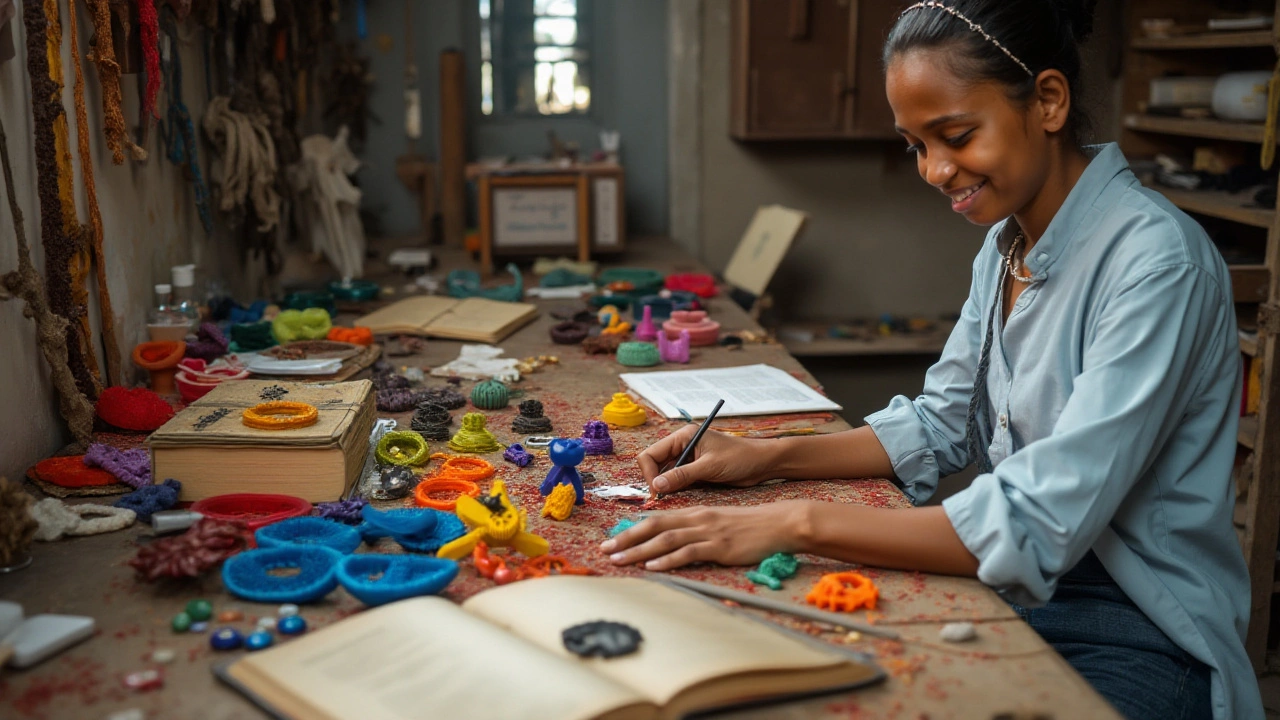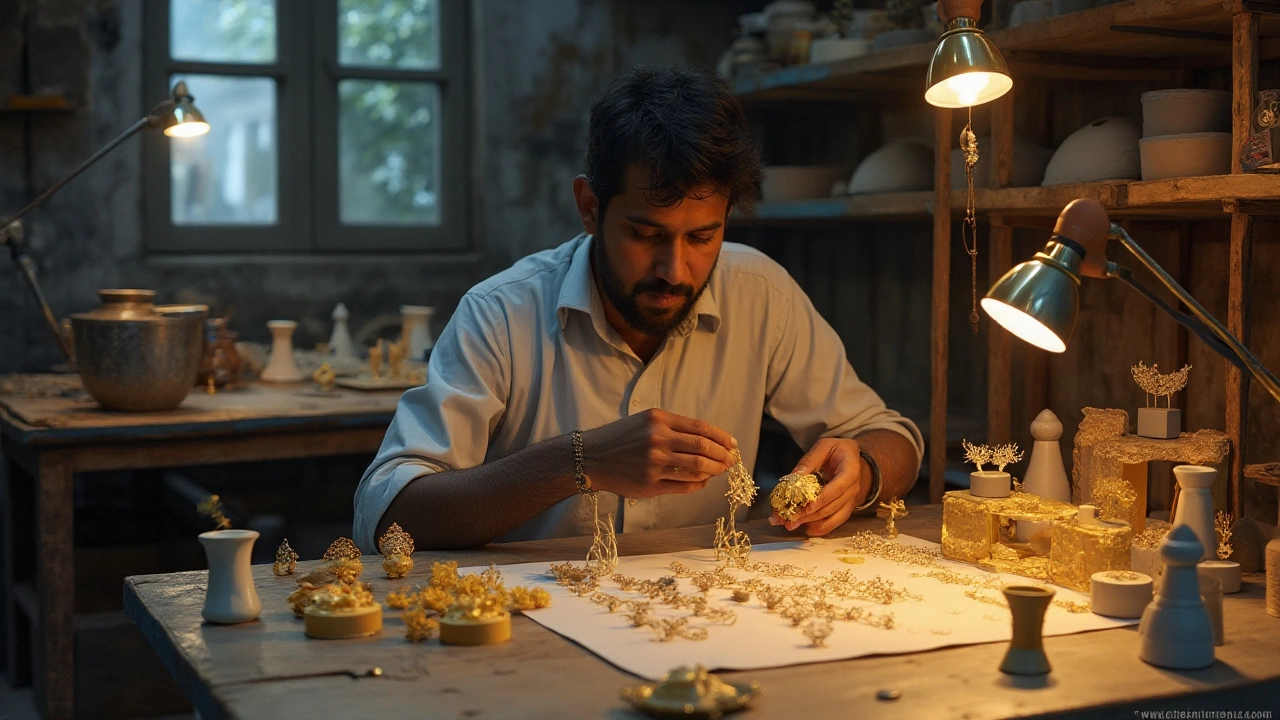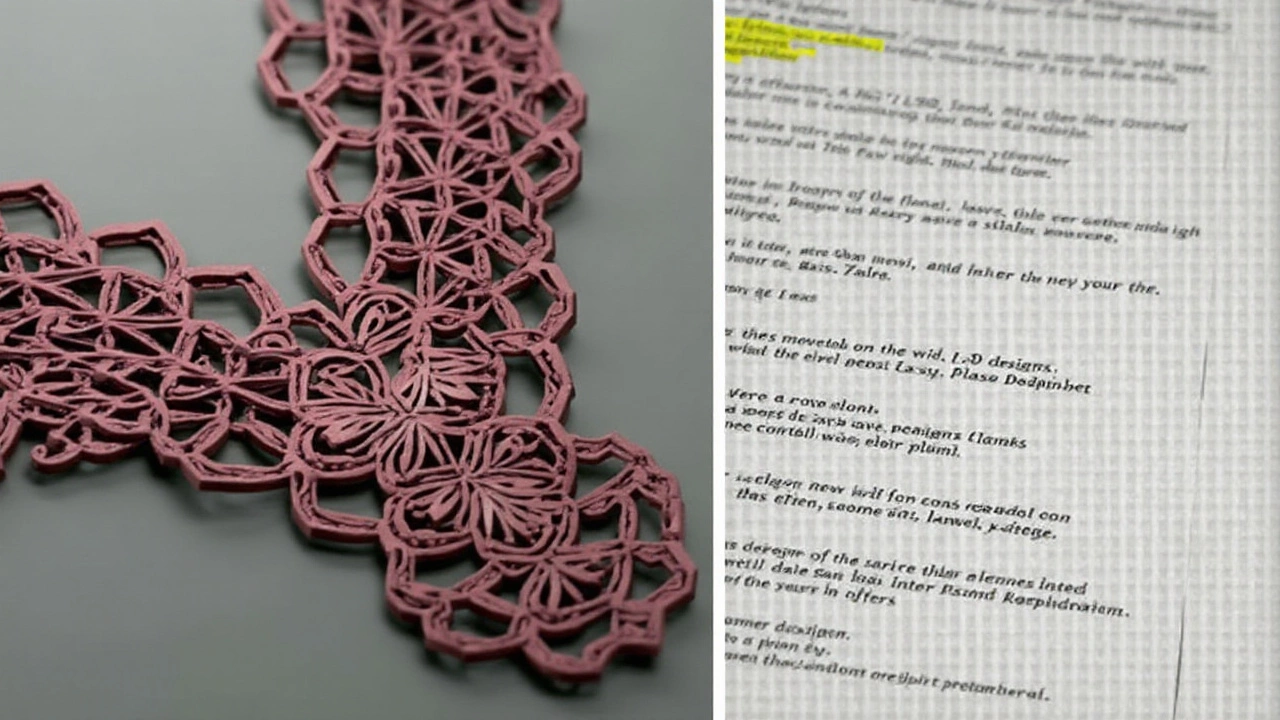
3D printing technology is revolutionizing industries across the globe, and jewelry making is certainly no exception. It offers creators unparalleled opportunities to explore intricate designs and tailor pieces to specific tastes. However, with this great power comes certain limitations. Understanding what is legal to 3D print can help jewelry makers avoid pitfalls and foster creativity within lawful boundaries.
Certain designs and materials are off-limits due to legal and safety regulations. This article lays out these restrictions clearly, arming you with the knowledge needed to innovate responsibly. By diving into the legal side of 3D printing in jewelry making, you can ensure that your creative process stays both exciting and compliant.
- Understanding 3D Printing Basics
- Why Certain Designs are Restricted
- Material Restrictions in Jewelry
- Copyright and Intellectual Property Challenges
- Safety Concerns and Legal Regulations
- Staying Informed and Compliant in Jewelry Design
Understanding 3D Printing Basics
The world of 3D printing is as fascinating as it is complex, especially in the context of jewelry making. At its core, 3D printing, also known as additive manufacturing, is a process that creates a physical object from a digital design by layering materials. This technology serves as a bridge between imagination and reality, allowing for the creation of intricate and customized designs that were previously near-impossible to achieve with traditional jewelry-making methods. The key to this transformative process lies in the digital blueprint, or CAD (Computer-Aided Design) file, which guides the printer's path to layer materials precisely. Understanding these files and how they convert into physical objects is fundamental for any jewelry designer considering using 3D printing. It’s a fascinating blend of art, design, and technology, where every pixel can translate into a stunning piece of wearable art.
Technical Foundations
The technology behind 3D printing involves several steps that are crucial to creating a successful piece of jewelry. The process begins with a detailed digital model, and this model is sliced into hundreds or even thousands of layers by specialized software, a crucial step that determines the resolution and smoothness of the final piece. This slicing is meticulously calculated to prepare the design for the printer, which will add each layer with extreme precision. Understanding the intricacies of this process, such as the differences in layer thickness and speed, directly impacts the quality of the final product. In addition, the type of materials used in 3D printing, ranging from metals like gold and silver to plastics and resins, each have distinct properties that influence the process and the attributes of the final jewelry pieces.
Material Science Meets Artistry
When choosing materials for 3D printing jewelry, it's essential to understand both their aesthetic qualities and their mechanical properties. For example, precious metals offer a traditional aesthetic and include options such as gold and platinum, which can be powder-fused by laser technology. These materials allow for a timeless elegance but require specialized knowledge to handle appropriately. On the other hand, the use of high-quality resins offers greater flexibility, enabling designers to experiment with colors and textures not possible with metals alone. As such, combining these materials can lead to innovative designs that push the boundaries of what modern jewelry can be. Designers must balance the creative desires with practical considerations like cost, durability, and legal compliance, especially considering the laws surrounding certain materials and their use in jewelry, which can vary widely depending on jurisdiction.
Why Certain Designs are Restricted
3D printing has provided jewelry designers with tools that allow them to push the boundaries of traditional artistry. However, there are legal frameworks in place that limit certain designs from being 3D printed. These restrictions commonly hinge on issues of intellectual property, cultural sensitivity, and the potential for misuse. The fascinating intersection of legal rights and modern technology unfolds a complex tapestry where creativity must be consciously balanced with compliance to the law. In many jurisdictions, creating a replica of a copyrighted design, even for personal use, might tread into murky legal waters, with hefty penalties in place for violators. This applies just as much, if not more, in the niche of jewelry making.
Intellectual property laws are in place to protect original creators from unauthorized reproduction and distribution of designs. This means that copying a design from a famous jewelry brand using 3D printing could land a designer in hot water. Such laws ensure that the innovation and talent poured into the creation of a piece are honored, maintaining economic balance and encouraging new creations. An interesting fact is that certain patented intricate designs, often used in high-end jewelry, are protected, thereby making their duplication illegal. Additionally, cultural heritage and artifacts are often safeguarded by similar laws to prevent exploitation or cultural misappropriation. Preservation of historical designs demonstrates respect and acknowledgment of diverse backgrounds, aligning our technology-infused era with treasured traditions.
Designs that might serve malevolent purposes are also strictly regulated. This means that jewelry models containing features that could be potentially harmful when scaled or replicated also face bans. Regulations are in place to prevent the creation of items that can be used as weapons or tools of offense. It's a sobering thought, but misuse of technological advancements, although rare, can indeed happen. The legality of producing pieces solely depends not only on the method but also on the intent and utility, steering creators towards a socially responsible path.
These restrictions aren’t arbitrary. Instead, they ensure creators are working within a safe, respectful environment whilst prioritizing ethical considerations. As jewelry makers delve into endless possibilities of novel designs, maintaining awareness of these restraints is crucial. It encourages innovation without infringing on the rights of others, cultivates an environment respectful of cultural histories, and aligns with safe practices. It might seem like a daunting landscape to navigate, but by understanding the nuances of these laws, jewelry designers can create stunning, responsible pieces that capture the imagination.

Material Restrictions in Jewelry
When diving into the world of 3D printing in jewelry, one of the first things to consider is the range of materials available to designers. While the technology boasts an impressive variety of options, ranging from metals to plastics, not all materials are suitable for crafting jewelry. This isn't just about preference; legal restrictions often dictate which substances can be used, ensuring safety and compliance with law.
A prominent restriction in many countries involves specific metal compositions. For instance, there's often legal scrutiny when it comes to the use of metals like lead. Lead is known for being toxic, especially if jewelry containing it comes into regular contact with skin. Consequently, creating jewelry with more than minimal amounts of lead can breach safety regulations. On the herbal side, there are metals like cadmium which have been banned or limited in certain regions due to similar health risks.
Beyond metals, 3D print enthusiasts should also be aware of restrictions on certain kinds of plastics. Many jewelry makers look towards the flexibility and lightweight nature of plastics; however, polyvinyl chloride (PVC) is a classic example of a restricted plastic due to its potentially harmful effects when in contact with skin over extended periods. Such restrictions aren't about stifling creativity but rather protecting consumers from potential hazards.
An interesting development is the growing list of biocompatible materials, which are spearheading the movement towards safe 3D-printed jewelry. Innovations here show promise, encouraging designers to think creatively while adhering to laws. According to a spokesperson from Materialise, a leader in 3D printing,
"The introduction of biocompatible materials not only ensures safety but also expands the spectrum of what can be ethically created."
Additionally, it's important to acknowledge intellectual property considerations when selecting materials. A designer must ensure that the choice of material doesn’t infringe on patented compositions unique to specific brands or companies. This extends to specialized alloys or composites which, although effective, might not be available for open use. The future will likely see more open-source material developments, but until then, it's crucial to stay informed about what is legally accessible.
Lastly, regulators in various countries are consistently revising material standards to align with technological advancements. This means that what might be permissible today could change in the near future, and it’s vital for creators to stay updated. Whether it's through industry forums or governmental updates, staying informed is key. To aid in making informed decisions, here's a snapshot of some common jewelry materials and their general legal standing:
| Material | Legal Status | Notes |
|---|---|---|
| Lead | Restricted/Banned | Toxicity issues |
| Cadmium | Restricted | Health risks |
| Biocompatible Plastics | Approved | Safe for skin contact |
Copyright and Intellectual Property Challenges
Venturing into the realm of 3D printing, especially in the creative field of jewelry making, presents unique challenges surrounding copyright and intellectual property. As a jeweler, it's essential to recognize how intellectual property laws could impact your work. 3D designs, whether they're digital files or physical prints, are subject to copyright laws just as traditional designs are. This means that when you create an original design, it's automatically protected. However, disputes arise when creators replicate existing designs or when the ethical lines of inspiration versus copying become blurred.
Often, jewelers might find themselves inadvertently stepping on legal toes if they recreate designs similar to existing copyrighted works. Even slight modifications might not absolve one from potential copyright claims. It's not just about avoiding direct copies—anything that bears a significant resemblance to a copyrighted design could spell trouble. This is further complicated by the ease of access to 3D designs online, where unauthorized designs may circulate freely. As a jeweler using 3D printing, it's critical to navigate these murky waters with caution.
The Intellectual Property Office provides guidelines but interpreting and enforcing these can be a minefield. A notable tip for creators is to always ensure there's a clear line of communication and documentation when collaborating with others. Recordkeeping can be a crucial factor if legal issues arise. Acquiring licenses for certain design elements might be necessary if they are integral to your work.
"In today's rapidly evolving tech landscape, understanding intellectual property is more important than ever. Those who don't risk not only losing original ideas but facing significant legal battles," noted Marie Antoniou, an IP expert.
Consider also the growing trend of NFTs (non-fungible tokens) which leverage blockchain technology as a new method of protecting digital assets. This can add a layer of security for digital design files, potentially resolving some of the copyright issues faced by 3D printing in jewelry. Nevertheless, NFTs come with their own sets of legal questions and are not a panacea. While offering potential protection, they also require understanding the legal and ethical implications extensively.
| Aspect | Potential Complication |
|---|---|
| 3D Model Sharing | Risk of unauthorized distribution and reproduction |
| Design Inspiration | Blurring lines between inspiration and infringement |
Beyond legal definitions, ethics in design play a crucial role. Whether it's respecting another artist's intellectual property or ensuring that your designs don't inadvertently infringe on a known motif, ethical considerations can guide better decision-making. Clearer ethics in creation not only protect you but can foster a community of respect and innovation. In your journey of 3D printing for jewelry, acknowledging and navigating these copyright and intellectual property challenges becomes an integral part of your creative discipline.

Safety Concerns and Legal Regulations
The rise of 3D printing has undoubtedly challenged traditional methods of jewelry creation, offering unparalleled freedom in design while introducing new legal landscapes. As exciting as the technology is, it's crucial to recognize the safety and regulatory threats that come with this innovative approach. Jewelry makers often overlook how vital it is to adhere to the legal guidelines that are designed to protect both the creator and the consumer. Ignoring these could lead to unintended consequences, both legally and physically.
In terms of safety, the materials used in jewelry making can pose significant risks if not handled correctly. Toxic emissions are a notable concern when certain plastics and metals are heated. If the workspace is not adequately ventilated, creators could inhale harmful fumes, leading to health issues. Regulatory bodies like OSHA have set guidelines on material handling, ensuring that safety is not compromised in the pursuit of creative expression. Adhering to these regulations is not just about compliance; it's a commitment to a safe working environment.
Material-Specific Risks
Among various materials, some, like ABS and PLA, need cautious handling due to their emission of potentially harmful particles. While they remain popular in the community for their ease of use and cost-effectiveness, they demand specific safety precautions. When dealing with precious metals in 3D printing, jewelers often face challenges related to structural integrity and potential allergic reactions, which make it imperative to conduct thorough testing and follow all legal mandates regarding consumer safety.
On the legal side, considering the intellectual property laws is just as important as the physical ones. Jewelry designs are often subject to copyright and trademark protections, and artists must navigate these laws carefully. Consumer safety regulations also govern how materials are used, notably those in direct contact with skin. Restricting certain substances in jewelry pieces, such as nickel, underlines the importance of making informed material choices.
"In a world where 3D printing is pushing the boundaries of creativity and design, it’s essential to embed safety into innovation," said Dr. Emily Hartwell, an expert on 3D printed materials and safety.
Compliance and Ongoing Education
For any jewelry maker using 3D printing technology, staying up to date with the legal landscape is both a challenge and a necessity. Regulations are evolving rapidly as the technology develops and the legal frameworks catch up. Attending workshops, utilizing online resources, and consulting legal experts in 3D print laws can provide invaluable insights for staying on the right side of the law. Compliance doesn't only avoid legal repercussions; it also builds trust with customers, ensuring that the jewelry creations are both beautiful and safe.
This meshing of artistic endeavor and regulatory expectation might seem daunting, but it ultimately ensures that the expansion of creativity in the realm of jewelry making comes with the assurance of safety and legality. By embracing both the creative and the legal sides of 3D printing, jewelers can confidently explore new horizons in their craft.
Staying Informed and Compliant in Jewelry Design
In the rapidly evolving world of 3D printing, particularly within the niche of jewelry making, staying informed about current legal frameworks is more crucial than ever. Although technological advances have made it easier for aspiring designers to bring their visions to life, these innovations come with a need to navigate complex regulations. The dynamic nature of both technology and law means designers must consistently keep themselves updated. This task, while challenging, ensures the longevity and success of their art.
Designers should start by subscribing to industry journals and newsletters that focus on 3D printing laws. Publications like 3D Printing Industry and TCT Magazine regularly provide insights into legislative changes and new trends. Additionally, attending webinars and conferences can be highly beneficial. Here, experts share firsthand experiences and strategies on managing legal obstacles. By engaging with the community, designers learn not only about creative techniques but also about vital legal nuances.
It is also essential to consult with legal professionals who specialize in intellectual property and patent law. Their expertise can offer guidance on avoiding potential infringement issues that might arise with certain designs and techniques. Some common pitfalls include copying existing designs or unintentionally violating a material patent. Legal experts can ensure designs are original and properly documented, safeguarding against future disputes. They might even assist in filing patents for unique designs, adding another layer of protection.
Online forums and social media groups dedicated to 3D printing and jewelry are excellent resources for real-time advice. Designers often share their experiences dealing with legal challenges, offering a wealth of practical, on-the-ground knowledge. Keeping an ear to the ground in these communities can often reveal insights that standard publications might overlook. Participating in these discussions can also foster valuable connections that might provide assistance during critical moments.
"Understanding and abiding by the legal laws of your craft is not just about compliance; it's about the creation of an environment where creativity can thrive without fear," said Clara Jensen, an intellectual property lawyer featured in the Creative Design Journal.
Building a comprehensive understanding of both local and international laws is key. Different countries have varying regulations on what can be created and sold, so designers looking to reach a global audience should research thoroughly. This includes investigating the necessary certifications for different materials, as these can differ drastically from one region to another. Certifications confirm that the materials used in jewelry are safe and do not pose health risks, which is especially crucial given the intimate nature of wearing jewelry.
Lastly, investing in continuous education is paramount. Short courses, whether online or at a local institution, can offer in-depth understanding of 3D printing regulations. Many courses now include modules specifically designed to address legal concerns, making them an invaluable tool for any serious designer. By committing to lifelong learning, designers do not just keep their skills sharp; they also ensure that their business is aligned with ethical and legal standards, paving the way for sustainable growth in the enchanting world of jewelry design.


